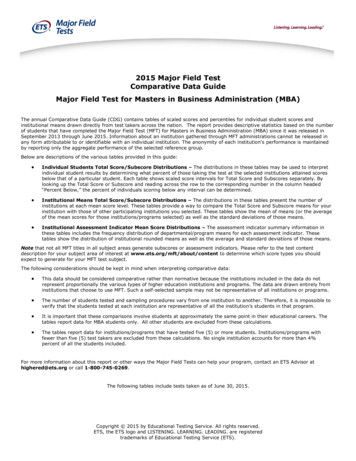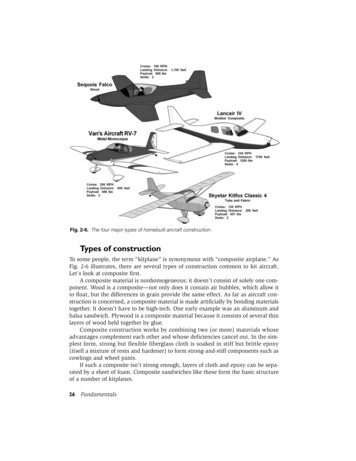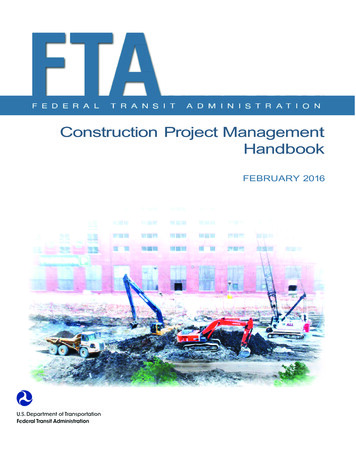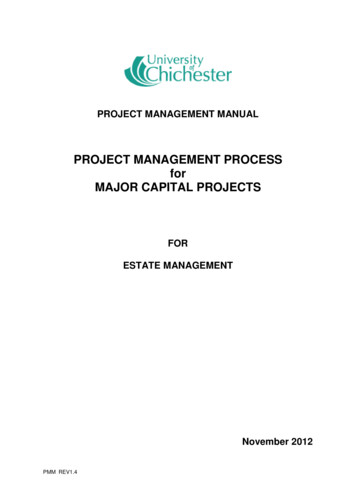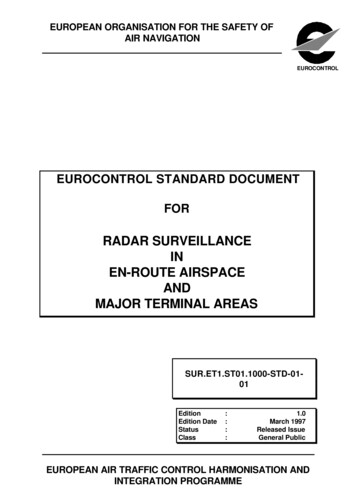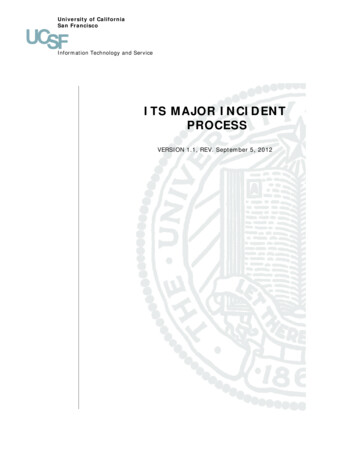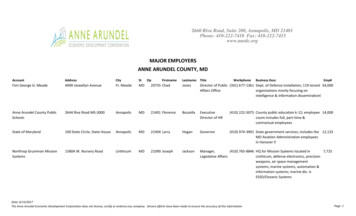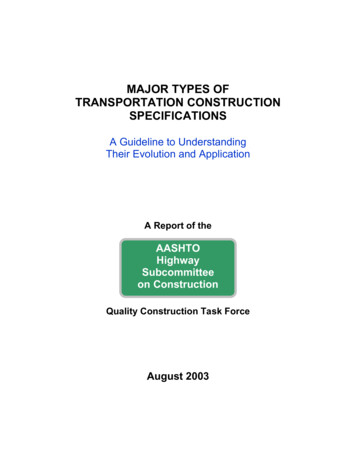
Transcription
MAJOR TYPES OFTRANSPORTATION CONSTRUCTIONSPECIFICATIONSA Guideline to UnderstandingTheir Evolution and ApplicationA Report of theAASHTOHighwaySubcommitteeon ConstructionQuality Construction Task ForceAugust 2003
INTRODUCTIONThis guideline to Major Types of Transportation Construction Specifications is publishedas a report of the Quality Construction Task Force of the AASHTO HighwaySubcommittee on Construction. Because it has not been ballotted by the AASHTOStanding Committee on Highways and the AASHTO Board of Directors, it is notconsidered an official AASHTO guide or voluntary standard.This Task Force Report was prepared by the Quality Construction Task Force of theAASHTO Highway Subcommittee on Construction. The Task Force principal author ofthe report is Mr. Gregory Doyle, Federal Highway Administration. The material in thisdocument was adapted from the New England Transportation Technician CertificationProgram (NETTCP) Quality Assurance Technologist Pilot Course Manual (February2001), co-authored by Mr. Robert Christman, Vanasse, Hangen, Brustlin, Inc. and Mr.Doyle. Photos, graphics, and assistance with document layout were provided by Mr.Richard Hamilton, Atech Center, Inc. Formal definitions have been included for eachtype of specification along with other minor revisions, based on feedback from membersof the Subcommittee. The definitions were developed or modified using the most recent"Glossary of Highway Quality Assurance Terms" (TRB Circular No. E-C037, April 2002)and were reviewed by Mr. Peter Kopac, Secretary of the TRB Committee onManagement of Quality Assurance (A2F03).The initial draft document was presented at the August 2001 Subcommittee onConstruction meeting. The members of the Construction Quality Task Force votedduring the August 2002 Subcommittee meeting to publish this Task Force Report andauthorized its distribution.The Subcommittee on Construction welcomes comments on this Task Force Report,and will consider all that are received. The report may be updated as needed andpublished as an official AASHTO guide document in the future. Comments on this TaskForce Report should be sent drectly to AASHTO at the address provided below.AASHTO Subcommittee on ConstructionAugust 2003American Association of State Highway and Transportation Officials444 North Capitol Street, NW, Suite 249Washington, D.C. 20001August 2003
TABLE OF CONTENTSMajor Types of Transportation Construction Specifications . 1Method Specifications . 2End-Result Specifications . 6Quality Assurance Specifications. 9Performance-Related Specifications . 13Performance-Based Specifications . 17Development of Quality Assurance Specifications. 19Transportation Construction Specifications Summary . 27August 2003
Major Types of Transportation Construction SpecificationsAASHTOHighwaySubcommitteeon ConstructionMajor Types of Transportation Construction SpecificationsGuideline OverviewThis document has been prepared to assist Transportation Agency and Contractorpersonnel in understanding different types of specifications that may be used. Over thepast few decades, many transportation Agencies have moved from “MethodSpecifications” to “Quality Assurance Specifications”. More recently, national researchefforts have focused on the development and implementation of “Performance RelatedSpecifications” and “Performance Based Specifications”. These different specificationtypes are sometimes not completely understood and are frequently referred tointerchangeably.Accordingly, this document explains how these different major types of tranportationconstruction specifications have evolved as well as how they should be properlydeveloped and applied. The following specification types are specifically presented:Method SpecificationsEnd-Result SpecificationsQuality Assurance SpecificationsPerformance-Related SpecificationsPerformance-Based SpecificationsAugust 20031
AASHTOHighwaySubcommitteeon ConstructionMajor Types of Transportation Construction SpecificationsMethod SpecificationsDefinition of Method SpecificationsMost Transportation Agencieshistorically have used what arereferred to as MethodSpecifications (Also calledMaterials & MethodsSpecifications, RecipeSpecifications, or PrescriptiveSpecifications). MethodSpecifications are defined asfollows:Method Specifications “Specifications that require the Contractor to produceand place a product using specified materials in definite proportions and specifictypes of equipment and methods under the direction of the Agency.”Overview of Method SpecificationsMethod Specifications, which have been commonly used since the 1940’s, placemaximum control and responsibility in the hands of the specifying Agency. Typically,these types of specifications:2 Provide a “cookbook” with specific “recipes” for the Contractor to follow Utilize Agency inspection, sampling, and testing to control the work Base Acceptance on “reasonable conformance” or “substantial compliance” Pay 100% across a range of QualityAugust 2003
Major Types of Transportation Construction SpecificationsAASHTOHighwaySubcommitteeon ConstructionA Method Specification spells out exactly theequipment, methods, materials, and techniques aContractor will be required to use. The Contractor orProducer is directed to combine specified materials indefinite proportions and use specific types ofequipment and methods in order to place thematerials or product in a prescribed way. Each step iscontrolled and in many cases directed by a Transportation Agency representative. Ineffect, the Agency rents the Contractor’s personnel and equipment. This type ofspecification does not allow the Contractor to be innovative.Some version of Method Specifications is still used today by many Agencies, but itusually includes a greater degree of materials testing than in the 1950’s. In the early useof Method Specifications, little or no testing was done. The specifying Agency basedacceptance primarily on inspection and did not, in many cases, have any defensiblemeans to have production facilities producing noncompliant materials shut down, require correctionor removal of deficient materials, or have paymentadjusted. Acceptance was determined based upon“substantial compliance” with the specificationrequirements. Acceptance decisions under MethodSpecifications are rather arbitrary since there is noestablished quality level defined by thespecification. Typically Method Specificationsrequire only that the product “must conformreasonably or substantially”. A specification underthese terms is difficult to uniformly enforce and hasquestionable legality if the Contractor has met thematerials and methods requirements, but is toldthat the work is not acceptable.August 20033
AASHTOHighwaySubcommitteeon ConstructionMajor Types of Transportation Construction SpecificationsEven though today’s Method Specifications may make greater use of test results foracceptance, they usually focus on test results for individual Field Samples. Each testresult is usually checked against the specification values (typically a maximum andminimum value is specified). It must be recognized that focusing on individual testresults ignores the inherent Variability inconstruction materials and relies on that singletest result to determine the acceptability oflarge quantities of material. When anindividual test “fails” under MethodSpecifications, it is difficult to determinewhether to correct the process, shut downproduction, or reject/remove material placed.Many materials engineers have been facedwith the dilemma of having to render a productacceptance or rejection based upon onesample. In short, it is like playing RussianRoulette! The one Field Sample could, just bychance, be an acceptable productrepresentation or, just by chance, berepresentative of an inferior product.The inherent problems posed by acceptance based upon “substantial compliance”and/or individual test results make it difficult to establish any objective procedures forprice adjustment. Method Specifications do not usually indicate whether or how contractprices should be adjusted for non-specification materials. Likewise, MethodSpecifications do not allow the Contractor to be rewarded for providing a higher qualityproduct than called for in the specification. Under a method specification, Contractorstypically receive 100% payment for the work completed, regardless of the level ofquality.4August 2003
Major Types of Transportation Construction SpecificationsAASHTOHighwaySubcommitteeon ConstructionDisadvantages of Method SpecificationsIn summary, the principal disadvantages of Method Specifications include: The Agency controls each step of the Contractor’soperation. The Contractor may not be allowed to use the mosteconomical or innovative procedures andequipment to produce the product sought. Materials Acceptance is based on inspection for“substantial conformance”. Decisions based on test results of individual Field Samples can increase disputesand confrontation between the Contractor and Agency. Contractor payment is not linked to product quality or long-term performance.August 20035
AASHTOHighwaySubcommitteeon ConstructionMajor Types of Transportation Construction SpecificationsEnd-Result SpecificationsDefinition of End-Result SpecificationsThe construction of the AASHO Road Test in 1958provided the first step toward End-ResultSpecifications. End-Result Specifications aredefined as follows:End-Result Specifications “Specificationsthat require the Contractor to take the entireresponsibility for producing and placing aproduct. The Agency’s responsibility is toeither accept or reject the final product or to apply a price adjustmentcommensurate with the degree of compliance with the specifications.”Overview of End-Result SpecificationsEnd-Result Specifications typically:6 Assign the Contractor complete responsibility and latitude in determining theprocedures and equipment used to produce the product. Leave Quality Control sampling, testing, and inspection entirely at the discretionof the Contractor or Producer. Base Agency Acceptance on sampling and testing of the final in-place product. Determine a price adjustment based upon the degree of compliance with thespecification criteria.August 2003
Major Types of Transportation Construction SpecificationsAASHTOHighwaySubcommitteeon ConstructionUnder End-Result Specifications, the Contractor or Producer takes the entireresponsibility for supplying a product or an item of construction. Thistype of specification does have the advantage of affording theContractor the greatest amount of flexibility in exercising options fordeveloping new techniques and procedures to perform the work andimprove the quality of the end product. True End-ResultSpecifications place no restrictions on the materials to be used orthe methods of incorporating them into the completed product.This is a well-meaning consideration, but is definitely outweighedby the inherent disadvantages.End-Result Specifications stress sampling and testing, as opposed to inspection, as themain measure of Agency Acceptance. “End-Result” is a term that defines the desiredquality of the finished product. The specification either accepts or rejects the finalproduct, or applies a penalty system that accounts for the degree of non-compliance.One of the principal objections to this type of a specification in the transportationconstruction industry is that a large quantity of material may be found to be defectiveafter it is already in place, when there is very little opportunity for correction. This is veryrisky from the standpoint of the specifying Agency accepting undesirable product. It alsodiscourages accumulating testing results throughout construction to obtain a morerepresentative estimate of the product quality. Practically speaking, it is difficult toenforce such a specification and the implications are involved with legal procedures andconcepts rather than sound engineering considerations.Another problem with this type of specification is determiningreasonable levels of acceptance and determining relationshipsbetween the materials properties and final productperformance. The Acceptance limits used on the AASHO RoadTest were developed by a panel of engineers who used theirexpertise to determine limits that they thought could be met bythe Contractor and which would lead to the desiredperformance of the product. The testing from the AASHO RoadAugust 20037
AASHTOHighwaySubcommitteeon ConstructionMajor Types of Transportation Construction SpecificationsTest, however, proved that the limits could not be met consistently. Specifications thathave Acceptance limits based solely on subjective judgment are often difficult to meetdue to a lack of definition of the capabilities of the production process and the desiredproduct. An estimate of the desired target value and the variability that can be toleratedare necessary to establish realistic specification limits. However, a valid acceptanceplan must be based on a scientific and engineering analysis of historical production datato establish practical target values and to identify inherent Normal Variability. Only whenthis is done can the specification be considered truly attainable and defensible.One approach that can often lead to problems is to combine a Method Specification withEnd-Result testing. This is potentially a very controversial specification and verydangerous. If the Contractor is directed as to what equipment to use and how to use it,and an End-Result requirement is also imposed on the product, disputes frequentlyresult. Combining stipulated methods with required end results may render such aspecification legally indefensible.Disadvantages of End-Result SpecificationsThe primary disadvantages of End-ResultSpecifications include:8 The responsibility for Quality Controlis often not clearly defined. Acceptance decisions based on the results of limited testing of the in-placeproduct do not provide for timely identification and correction of non-compliantmaterial and may unfairly reject acceptable material. The specification Acceptance target values and limits are often based onsubjective “experience” rather than an analysis of historical data.August 2003
Major Types of Transportation Construction SpecificationsAASHTOHighwaySubcommitteeon ConstructionQuality Assurance SpecificationsDefinition of Quality Assurance SpecificationsThe use of Quality Assurance Specifications, which were initially called “StatisticallyBased Specifications”, began in the 1960’s. Quality Assurance Specifications aredefined as follows:Quality Assurance Specifications “Specifications that require ContractorQuality Control and Agency Acceptance activities throughout production andplacement of a product. Final acceptance of the product is usually based on astatistical sampling of the measured quality level for key Quality Characteristics.”Overview of Quality Assurance SpecificationsThe Quality Assurance Specification is a more rational form of specification that clearlydelineates Contractor and Agency responsibilities and determines payment on themeasured construction quality level. Quality Assurance Specifications:August 2003 Recognize the inherent Variability of materials Assign Quality Control (QC) sampling, testing, andinspection to the Contractor Include Acceptance sampling, testing, and inspection bythe Agency Identify the specific Quality Characteristics to bemeasured for Acceptance Provide price adjustments related to quality level of theproduct9
AASHTOHighwaySubcommitteeon ConstructionMajor Types of Transportation Construction SpecificationsQuality Assurance specifications are to be both practical and realistic because they areto provide a rational means for achieving the highest overall quality of the material orconstruction, while recognizing and providing for the Variability of the process andproduct. Quality Assurance Specifications for transportation construction were derivedfrom U.S. Department of Defense specifications (Military Standard 414 – SamplingProcedures and Tables for Inspection by Variables for Percent Defective). This was theintroduction of the Quality Assurance Specification as we know it today. This type ofspecification is based on proven mathematical probability (statistical) principles forNormal Variability that provides for a more realistic assessment of the degree ofconformance to the specification criteria.Under a Quality Assurance Specification, the Contractor is responsible for QualityControl (QC) and the Transportation Agency is responsible for Acceptance of theproduct. Placing responsibility for Quality Control sampling, testing, and inspection inthe hands of the Producer and Contractor is consistent with what is normally required invirtually all other business sectors that manufacture or produce products (e.g.electronics, appliances, automobiles, airplanes, food items). As part of their Acceptanceresponsibilities, Agency technicians and inspectors must monitor the Contractor’s QCactivities and still have a responsibility for Acceptance sampling, testing, and inspection.10August 2003
Major Types of Transportation Construction SpecificationsAASHTOHighwaySubcommitteeon ConstructionThe specifying Agency must determine what material attributes (Quality Characteristics)are essential to good performance and what the limits are within which the material orwork can be produced to assure good performance over the design life of thetransportation product. This requires astute materials engineering. For Hot Mix Asphalt(HMA) pavements, an example of two principal Quality Characteristics that can bemeasured, which are critical to good pavement performance, are the density of thecompacted pavement and pavement smoothness. For Portland Cement Concrete(PCC) structures and pavements, we can use compressive strength, air content andsmoothness. Soils properties that can be measured for good performance may includein-place density and gradation.Quality Assurance Specifications normally determine priceadjustment based upon a mathematical assessment of themeasured Variability of the product. Although pay factors havesometimes been included in Quality Assurance Specificationsdue to the concerns of Contractors, it cannot beoveremphasized that pay adjustment linked to measuredquality levels is intended to provide both the Contractor and theAgency with a more equitable measure of value received.Usually, Quality Assurance Specifications provide: Increased payment (typically 101-105%) for superior quality work.(Note: Some Agencies may pay as much as 110-115%) Reduced payment (typically 0-99%) for lesser quality work.Work that is determined to be below a minimum quality level is normally rejected by theAgency and may be subject to reduced payment, removal and replacement, or someother corrective action.August 200311
AASHTOHighwaySubcommitteeon ConstructionMajor Types of Transportation Construction SpecificationsAdvantages of Quality Assurance SpecificationsAs briefly discussed above, some of the key features and corresponding advantages ofQuality Assurance Specifications include the following:12 QA Specifications are mathematical probability based specifications that utilizeRandom Sampling and Lot-by-Lot testing. QA Specifications let the Contractor know if his operations are producing anacceptable product on a real-time basis. QA Specification
document was adapted from the New England Transportation Technician Certification Program (NETTCP) Quality Assurance Technologist Pilot Course Manual (February 2001), co-authored by Mr. Robert Christman, Vanasse, Hangen, Brustlin, Inc. and Mr. Doyle. Photos, graphics, and assistance w
